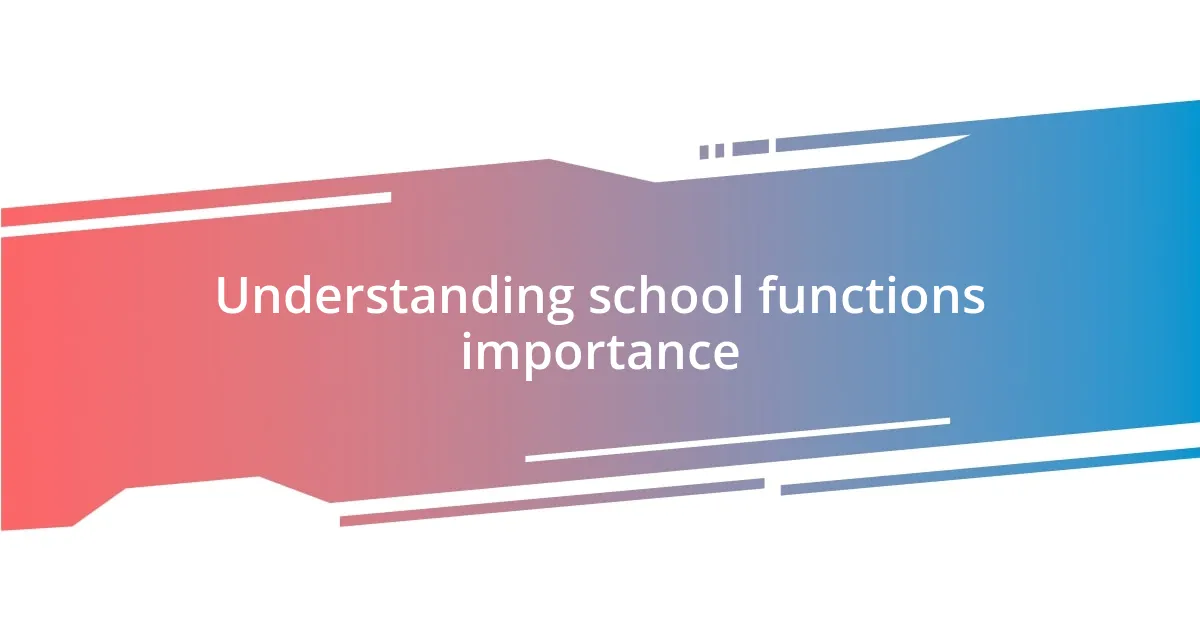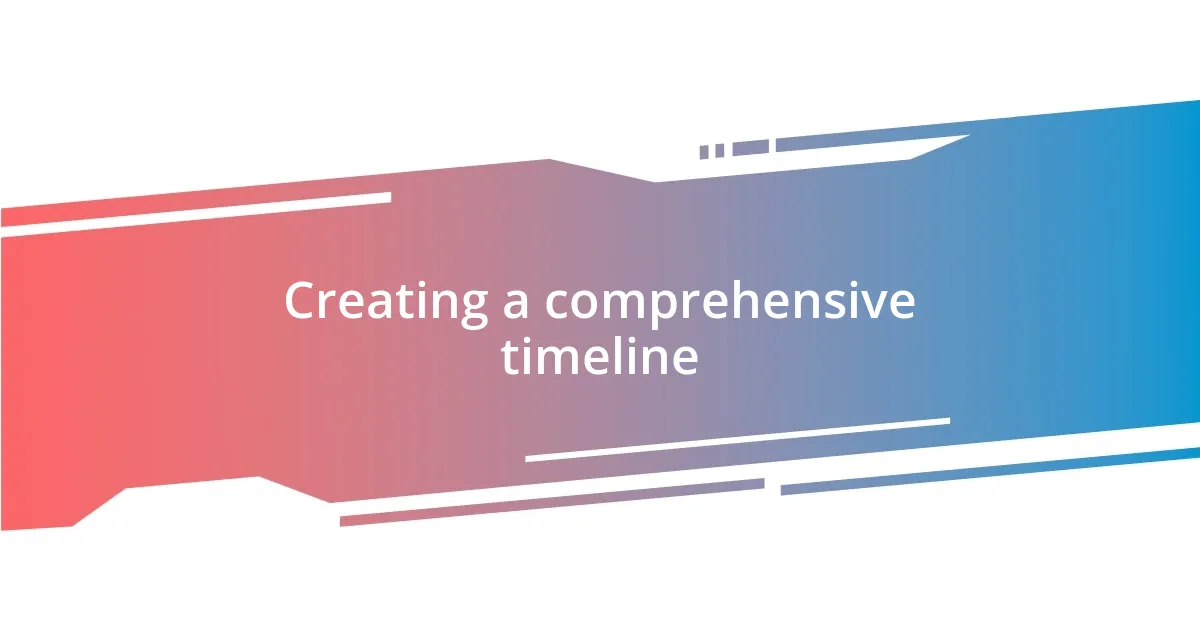Key takeaways:
- School functions foster community, enhance student skills, and provide hands-on learning experiences.
- Clear planning roles, realistic budgeting, and comprehensive timelines are essential for successful events.
- Engaging stakeholders through communication and feedback strengthens community involvement and improves future events.
- Continuous reflection and implementation of feedback lead to growth and enhanced experiences for participants.

Understanding school functions importance
School functions play a pivotal role in fostering a sense of community and belonging among students, parents, and educators. I vividly remember attending a spring fair in my school days. It wasn’t just about fun and games; it was an opportunity for parents to connect and for us students to showcase our talents, creating bonds that lasted long after the event.
Moreover, these functions offer a platform for students to develop essential skills such as teamwork, leadership, and public speaking. Think about it: when have you seen a shy student shine on stage? Those moments not only boost their confidence but also encourage them to step out of their comfort zones. Personally, I was that timid kid, and when I finally participated in a talent show, the applause felt like a warm embrace that ignited my passion for performing.
Finally, school functions serve an educational purpose, too, blending fun with learning. Whether it’s a science fair or a cultural day, these events allow students to explore subjects in a hands-on way. I remember participating in a history night where each class represented a different time period. The excitement on my classmates’ faces as we brought history to life was palpable; it made learning feel less like a chore and more like an adventure. Isn’t that the kind of experience every student should have?

Identifying key planning roles
Identifying key planning roles is crucial to ensuring a smooth and successful school function. I recall the time when I volunteered to help organize a fundraising event; it quickly became clear how vital each player’s role was in making the day a success. From the enthusiastic parent coordinators to the students who brought their creative flair, every contribution mattered, reminding me of a well-orchestrated symphony.
Here’s a breakdown of some essential planning roles to consider:
– Event Coordinator: Oversees the entire function, juggling logistics while keeping the team motivated.
– Budget Manager: Keeps track of finances, ensuring we can bring visions to life without emptying pockets.
– Volunteer Coordinator: Recruits and manages volunteers, crucial for filling all the roles necessary for a successful event.
– Marketing and Communication Lead: Crafts compelling messages to promote the event, engaging the school community.
– Activity Planner: Designs interactive activities and schedules, ensuring every moment is engaging for participants.
I’ve seen how a dedicated team, each with distinct responsibilities, can turn a stressful planning phase into a collaborative and enjoyable experience. Each role conveys a sense of ownership, making it clear that we’re all working towards a common goal, just like in my own experience of being part of the setup team for a talent show. The excitement felt when we see everything come together brilliantly is irreplaceable.

Establishing a realistic budget
Establishing a realistic budget is one of those foundational steps that can make or break a school function. I remember when I first assisted in planning a school carnival. The thrill of brainstorming ideas was palpable, but once the excitement settled, we faced a stark reality—money doesn’t grow on trees. We needed to account for everything, from decorations to food, ensuring we didn’t lose sight of our financial limits.
It’s all about balancing dreams and dollars. For instance, we wanted a fantastic magician for the event. Estimating his fee was necessary, but we also had to consider other costs that seemed smaller yet added up quickly, like tables, chairs, and even port-a-potties. This experience taught me that prioritizing your needs and wants within your budget is essential. Additionally, involving the community for donations or partnerships can significantly relieve financial pressure, just as we relied on local businesses to support our carnival.
Every dollar counts. I suggest creating a detailed spreadsheet to track income and expenses. It helped me visualize where the money was going. When things got tight, I was able to suggest simpler alternatives without sacrificing the fun. By keeping track of every cent, I felt a sense of control, rather than the chaos I initially feared. Looking back, that budgeting process was not just about numbers; it transformed my understanding of what it takes to make an event memorable.
| Expense | Estimated Cost |
|---|---|
| Decorations | $200 |
| Entertainment (Magician) | $300 |
| Food and Beverages | $500 |
| Permits and Insurance | $100 |
| Miscellaneous (e.g., tables, chairs) | $150 |

Creating a comprehensive timeline
Creating a comprehensive timeline is an essential part of planning any school function. I remember when I was tasked with coordinating a school dance; initially, the timeline felt overwhelming. I learned that breaking the process into clear phases—like securing the venue, arranging for decorations, and confirming entertainment—made it more manageable. Each milestone became a small victory that kept me motivated.
I recommend using a visual tool like a Gantt chart to plot out tasks. It’s incredibly satisfying to see everything laid out, helping to identify potential bottlenecks early in the process. One year, as we approached the school play, we noticed that we had scheduled rehearsals too close to the set-up day. It became apparent we needed to adjust; the last-minute scramble would have led to chaos. By visualizing our timeline, we adapted and ensured a smooth flow.
Moreover, deadlines should not just exist on paper; they’re what connect the team to a collective goal. I’ve found that sharing the timeline with everyone involved creates a sense of accountability. For our recent fundraiser, I encouraged team members to check off their tasks as they completed them. Watching the list shrink brought a sense of accomplishment and camaraderie—almost like crossing off items on a shared bucket list. How do you ensure everyone is on the same page? An updated timeline that everyone can access makes a tremendous difference. It’s all about clear communication and shared vision.

Engaging stakeholders effectively
In my experience, effectively engaging stakeholders means really understanding who they are and what they bring to the table. When we planned a fundraising event, I made it a priority to reach out to parents, teachers, and local businesses early on. What surprised me was how eager many were to contribute their skills and resources. Imagine the excitement of seeing a local bakery volunteer to donate treats, just because they loved our school spirit! Engaging stakeholders not only builds a stronger community but also creates an atmosphere of collaboration where everyone feels valued.
Regular communication is key to keeping everyone on the same page. I remember when we organized a science fair and sent out updates through emails and social media. It was essential to keep everyone informed about deadlines and changes. Yet, I learned that merely sending updates isn’t enough. I tried hosting small check-in meetings, which transformed our communication from a one-way street into an engaging dialogue. Did it take extra time? Absolutely. But the boost in enthusiasm and teamwork was well worth it, as it fostered a sense of ownership among all stakeholders.
Involving stakeholders also means recognizing their contributions in meaningful ways. After our annual school gala, I sought feedback from volunteers and sponsors through a simple online survey. Not only did it show them that their input mattered, but it also provided invaluable insights for our future functions. Reflecting on this, I always ask myself: How can we acknowledge and appreciate those who help bring our visions to life? Establishing genuine connections and showing gratitude can go a long way in solidifying support for upcoming events.

Evaluating success post-event
Evaluating the success of an event goes beyond just looking at numbers; it’s about capturing the overall experience. For instance, after our last talent show, I gathered my team for a candid discussion. We didn’t just analyze ticket sales and attendance—although those were important—but also shared what moments moved us the most. I remember one heartfelt performance that brought many parents to tears; that kind of emotional connection is incredibly telling about an event’s impact.
Feedback is crucial in this evaluation process. I sent out a survey to attendees after the school carnival, asking what they enjoyed and what could be improved. Surprisingly, many shared thoughtful suggestions and positive memories. It made me realize how important it is to give people a voice. Have you ever considered how much you could learn from just listening? In my experience, people appreciate being part of the conversation, and their insights can become a guiding light for future events.
Lastly, reflection plays a significant role in assessing what worked and what didn’t. I like to take some time to sit with my notes and feedback. During one reflection session after a cultural festival, I realized that, while the food was a hit, the entertainment portion felt rushed. This taught me to allocate more time for performances next time. As I ponder these lessons, I often ask myself: How can we continuously improve if we don’t take the time to reflect on our journey? Embracing a mindset of growth helps me and my team create even better experiences for everyone involved.

Implementing feedback for improvement
I’ve found that implementing feedback is one of the most critical steps in improving future school functions. After hosting a winter concert, I felt a mix of excitement and anxiety when I reviewed the feedback. While the performances were praised, many parents mentioned the long lines at the snack table. I didn’t just see this as criticism; it was an opportunity for growth. So, I organized a brainstorming session with my team, and we came up with a plan to streamline concessions for next time. The idea of transforming a challenge into a solution really resonates with me.
Personal stories from attendees also add immense value to the feedback process. At one event, a student approached me to share how much they loved the theme but felt that the decorations didn’t quite match. I realized that consulting with students—our primary audience—could provide insights I might overlook. Reflecting on their perspective made me rethink our approach entirely. Have you ever considered how different viewpoints can enhance the vibrancy of your events? It’s that diversity of thought that fosters creativity when planning.
Additionally, I always try to show appreciation for the feedback received. Following our spring festival, I made it a point to send thank-you notes to everyone who participated in the survey, highlighting specific suggestions they made. It not only validated their opinions but also encouraged them to continue sharing their thoughts in the future. Isn’t it amazing how a little acknowledgment can inspire more open communication? Embracing these insights fosters a collaborative spirit that drives positive changes and builds a stronger community around our school functions.















